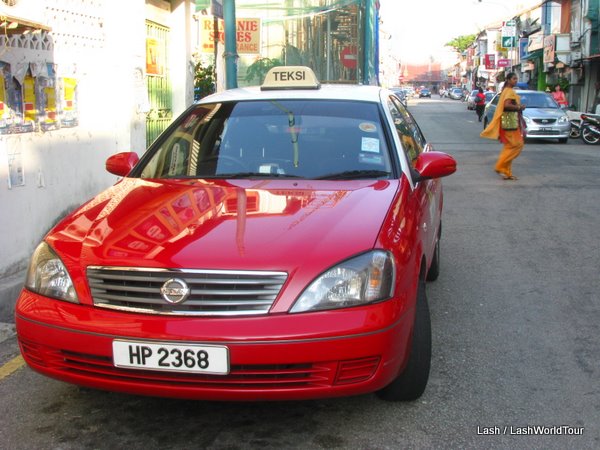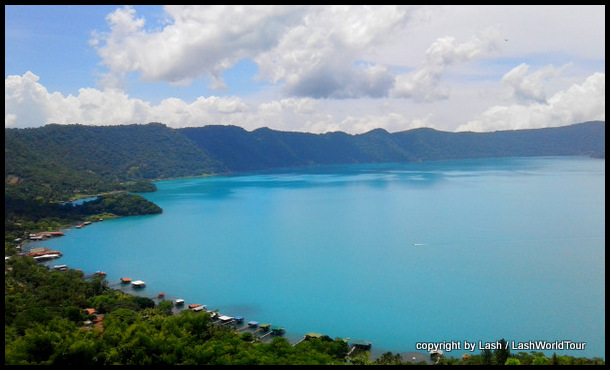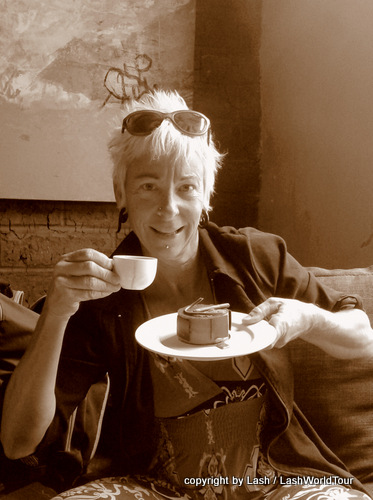
El Merced Cathedral – Antigua, Guatemala
10 Things I Love About Central America
1. It’s Very Affordable for Budget Travels
Central America, like South East Asia, is a great region for budget travelers. Although Mexico is cheaper (depending on the exchange rate) I’ve been able to travel through all the countries here on an average of $600 US per month or less.
Before coming here, I read several other travel bloggers’ travel costs for each country in this region and noticed that they generally found great cost differences between each country. Many travelers have particularly raved about how ultra cheap Nicaragua is.
Personally, I’ve found that every country cost me about the same, averaged over the months I spent in each, except for Belize, which is definitely more expensive by about 50%.
I’ve found eating at local ‘comedors’ in each country costs about the same: $2-3 US per meal, with the exception of Honduras, which I found a lot more costly for food.
I’ve been able to sleep in every country for $5-10 US per night. Sometimes that’s in a dorm, sometimes that’s for a private room (even within the same country!).
And public transportation in this region is incredibly cheap. I’m talking $0.50-2 US for overland trips taking 30 minutes to 2 hours. More expensive but comfortable shuttle vans, micro-buses, luxury buses and share taxis are available as well in many places.
All in all, as I said, I’ve averaged about $600 US per month or less in every country here. And Nicaragua is no longer super cheap, but has caught up to rates of neighboring countries.

2. Share Taxis
In my recent article about things I DISlike in Central America, I ranted about the terrible, over-crowded, excrutiatingly sllllowww public buses.
On the other hand, the region’s share taxis are awesome. Operating in most towns and cities in the region, share taxis work like tiny public buses in a way. Instead of having a taxi all to yourself, you might be sharing it with other passengers along the way.
That does mean that the driver might stop several times to let people off at their destinations and pick up new passengers en route. But since a taxi only has four seats, it’s all very quick. And it gives door-to-door service, unlike buses.
Best of all, share taxis are incredibly cheap. In Nicaragua, for instance, each town or city has a standard fare for any destination within the city. In Leon it’s 30 cordobas / $1 US. In Granada it’s 20 cordobas / 0.65 US. In Esteli and Matagalpa it costs a whopping 10 cordobas / 0.35 US. Even I can afford taxis at these rates !

Volcanoes at Lake Atitlan
3. Volcanoes
I don’t know about you, but I think volcanoes are very cool. I love their conical shapes, smoking, stark landscapes and intriguing craters.
Over the years I’ve admired and climbed many volcanoes in various countries. Each one is unique. Some are perfectly conical, others feature jagged rim silhouettes. Some have bare, volcanic gravel slopes while others are completely covered in dense forests or other vegetation. Some have craters with a lake, others with boiling mud and steam, others billowing dense smoke, and still others with burning lava.
In Central America almost every country is dotted with volcanoes, some active and some dormant. They add a lot of beauty and interest to the landscape. Many of them can be climbed and in Nicaragua they also have volcano boarding, where you slide down volcanic slopes on a wooden sled.

Las Pinitas Beach – near Leon
4. Au Naturale Beaches
Every Central American country has at least one coastline with beaches on the Pacific or the Caribbean. Belize has extensive Caribbean coast while El Salvador has a long Pacific coast. All the other countries – Guatemala, Nicaragua, Honduras, Costa Rica and Panama – have coastal beaches on both the Pacific and Caribbean.
Pacific beaches tend to be great for surfing, with pounding seas, waves and rough waters. Caribbean beaches and islands feature stunning turquoise and aquamarine water, coral reefs and powdery white or golden sands.
Some of these beaches in every country have become quite developed and known for nightlife and seafood restaurants. (not my scene) But many other beaches are still in a fairly undeveloped, low-key, au naturale state.
Guatemala has extensive dark, volcanic sand beaches at Monterico on the Pacific Coast. El Salvador’s El Cuco Beach, near the border of Honduras, begins at a small fishing village full of thatched beach restaurant and stretches several miles, backed solely by trees and vegetation. Honduras has the Caribbean islands of Roatan and Utila. Nicaragua has dozens of little-developed beaches along its vast Pacific coast as well as the remote Corn Islands in the Caribbean.
I haven’t explored Costa Rica or Panama yet, but I know from research that both countries have many beaches and bays full of little pristine islands.

beautiful Lake Coatepeque – El Salvador
5. Crater Lakes
Since Central America is dotted by volcanoes, the region is also blessed with dozens and dozens of pretty crater lakes of all different sizes and colors.
Some of these crater lakes you can only see by climbing several hours up a volcano to the crater rim and peering down inside. Santa Ana Volcano in El Salvador and Madera Volcano on Ometepe Island in Nicaragua are like this.
Other crater lakes are situated much closer to the surrounding ground level, set inside ancient, dead volcanic crater beds. These types of crater lakes range in size from huge to tiny and are often surrounded by dense forest or vegetation that covers the inner crater walls down to the lake shore. Famous Lake Atitlan in Guatemala, beautiful Lake Coatepeque in El Salvador, Lake Apoyo & Lake Masaya in Nicaragua are like this.
Generally visitors to these sorts of crater lakes can swim, kayak, boat, fish and sometimes scuba dive in the waters. There are generally hotels, hostels and guest houses for overnight stays as well.

enjoying waterfalls on Ruta de Flores
6. Diversity of Nature and outdoor adventures
It’s probably apparent by now that this region offers a very diverse range of natural environments.
Besides all the beaches, dramatic volcanoes and crater lakes, there are mountain ranges, flat plains, waterfalls, rivers, natural lakes. There’s also huge diversity of forest types: rain forests, cloud forests, dry highland forests, Many of these areas are preserved in national parks and nature reserves.
All this natural diversity lends itself to heaps of great outdoor adventures. Visitors can summit volcanoes, go river rafting, hike, camp, swim…well just about every activity you’d enjoy in nature, short of snow sports, you can do in Central America.

Granada – Nicaragua
7. Gorgeous Colonial Towns
Although Central America doesn’t have nearly as many gorgeous colonial towns and cities as Mexico, there are a few little beauties in the region. Most notable are Antiqua, Guatemala and Leon & Granada in Nicaragua. Other minor towns in most countries here also have a smattering of stunningly renovated colonial buildings and churches.
I love this type of architecture so much that whenever I’m in one of these gorgeous colonial towns I just automatically feel happy. I simply have to step outside my guest house and I’m surrounded by beauty. Actually, many of the guest houses, hotels and hostels I stay at are set in renovated historic buildings, too, so I can even admire great architecture and interiors while I’m ‘at home’.
8. Fried Plantains
Plantains are a hardier, larger cousin of bananas. Unlike bananas, plantains need to be cooked to eat. I’ve tasted them cooked in a variety of ways in this region of the world, but my favorite are the sticky, sweet soft fried plantains. And Guatemalans seem to make them the best, serving them with breakfast de rigour. Mmm, mmm. Great way to start the morning!

enjoying espresso
9. Great Coffee
All the Central American countries have large world-class coffee plantations and production industries, perhaps with the exception of Belize. It’s a great region for visting coffee farms, learining about growing and processing coffee. There are also coffee museums in several towns with extensive explanations.
But the best part, of course, is having so many cafes and places to buy top quality coffee.
However, I do have to admit that I personally don’t have the easiest time finding coffee I like, despite being constantly surrounded by the world’s best coffee plantations. I happen to prefer dark roast coffee, not medium roast. The two have completely different flavors.
Quite unfortunately for me, nearly every hotel, cafe and restaurant throughout the entire region serves only medium roast coffee! Even when they make espressos. It’s quite rare to find any place serving dark roast coffee. So I’m generally out of luck for hanging out in cafes. That means I always carry my own dark roast and French press to make my own in my hotel or hostel.
However, it can be equally difficult to find dark roast for sale anywhere, including cafes, coffee roasters and super markets. It’s just not very popular here, apparently.
So far, Nicaragua has been the easiest. I’ve been able to buy excellent dark roast coffee in any supermarket around the country. Yippie. Guatemala was quite difficult, but not impossible. In El Salvador it was not possible to buy dark roast coffee…except at Starbucks in San Salvador.
So although I’m very happy to be surrounded by great coffee plantations here, I do still have my work cut out for me finding the coffee I prefer. At least it is feasible.

visiting Flor de Cana Rum factory – Nicaragua
10. Inexpensive Rum
Anyone who knows me or has been following me a while probably knows that I’m not a fan of beer or wine. Howeer, I do love me some cocktails! In particular, I love white rum, vodka and gin…and a variety of cocktails made rom them.
Quite luckily for me then, Mexico and Central America all sell these spirits at very low prices. Rum, in particular, is very very inexpensive. After all, rum was created in Cuba then moved on to Puerto Rico (now home of Bacardi) and other Central American countries. Most countries here have at least one national brand of rum.
Much to my delight, Nicaragua produces some of the world’s best rum! Flor de Cana rum has a whole slew of international awards and is regularly voted #1 Rum in the World! As I found out on their rum factory tour recently, in 2017 they were also awarded #1 Rum Company in the world, due to their very impressive social and ecological practices.
So in this region of the world, I can pick up a high quality bottle of rum for a few dollars in a super market and mix up a bunch of tasty mojitos and daiquiries just about any time I like.
You might also like:
My Introduction to El Salvador
13 Surprising Facts about Guatemala
===================================================











 Hi! I'm Lash, an American nomadic world traveler who's been traveling solo since 1998. I’m passionate about traveling the world nomadically and then sharing it all with you. I hope to inspire you to travel the world, to entertain you with tales from the road, and to help you reach your travel dreams. Welcome!
Hi! I'm Lash, an American nomadic world traveler who's been traveling solo since 1998. I’m passionate about traveling the world nomadically and then sharing it all with you. I hope to inspire you to travel the world, to entertain you with tales from the road, and to help you reach your travel dreams. Welcome! 



